Attachment in Early Childhood Education
VerifiedAdded on 2023/01/19
|9
|2380
|62
AI Summary
This write-up explores the issue of attachment in early childhood education, discussing the Attachment theory by John Bowlby, the stages of attachment, factors that influence attachment, patterns in attachment, challenges and problems associated with attachment, and the importance of attachment in an individual's life.
Contribute Materials
Your contribution can guide someone’s learning journey. Share your
documents today.
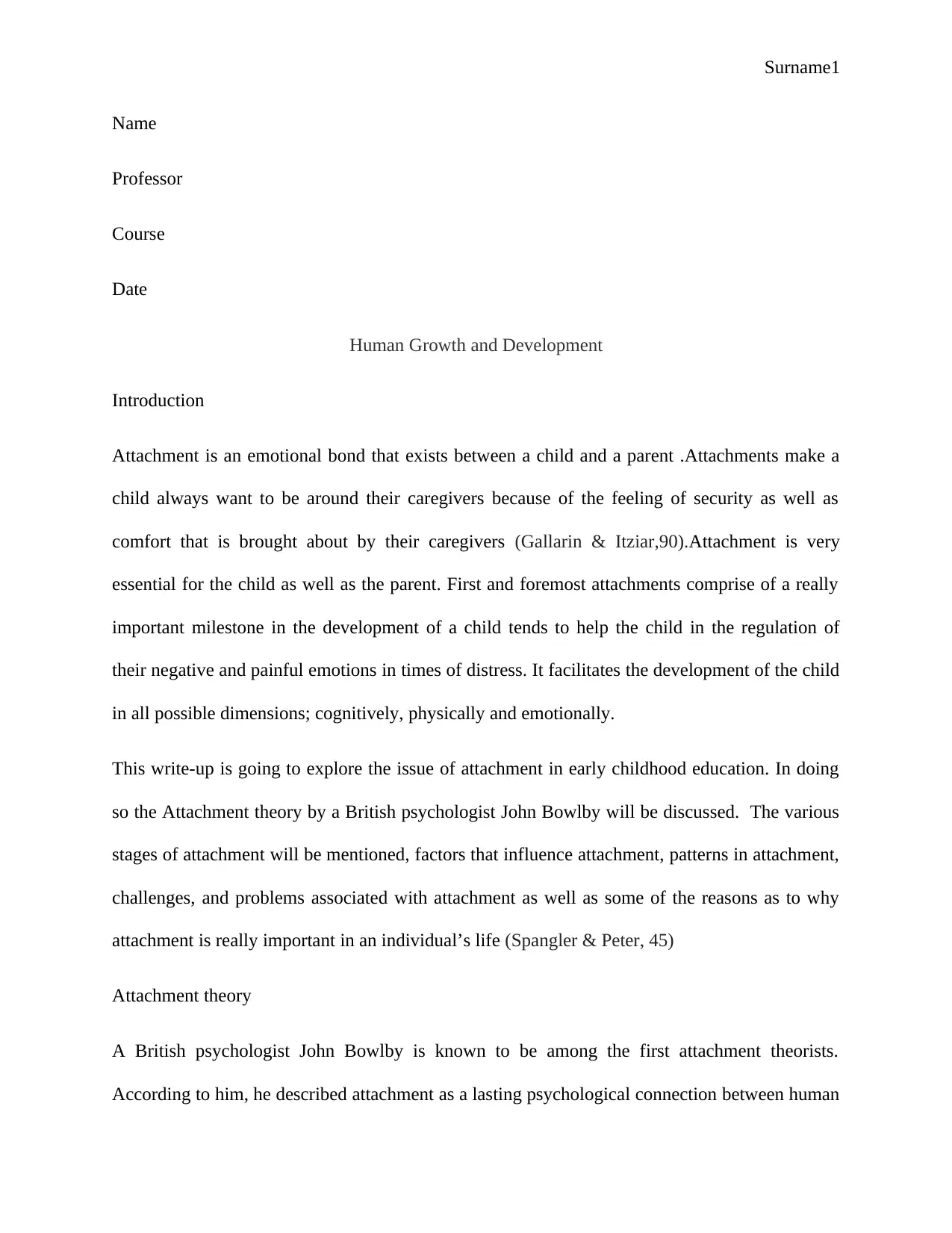
Surname1
Name
Professor
Course
Date
Human Growth and Development
Introduction
Attachment is an emotional bond that exists between a child and a parent .Attachments make a
child always want to be around their caregivers because of the feeling of security as well as
comfort that is brought about by their caregivers (Gallarin & Itziar,90).Attachment is very
essential for the child as well as the parent. First and foremost attachments comprise of a really
important milestone in the development of a child tends to help the child in the regulation of
their negative and painful emotions in times of distress. It facilitates the development of the child
in all possible dimensions; cognitively, physically and emotionally.
This write-up is going to explore the issue of attachment in early childhood education. In doing
so the Attachment theory by a British psychologist John Bowlby will be discussed. The various
stages of attachment will be mentioned, factors that influence attachment, patterns in attachment,
challenges, and problems associated with attachment as well as some of the reasons as to why
attachment is really important in an individual’s life (Spangler & Peter, 45)
Attachment theory
A British psychologist John Bowlby is known to be among the first attachment theorists.
According to him, he described attachment as a lasting psychological connection between human
Name
Professor
Course
Date
Human Growth and Development
Introduction
Attachment is an emotional bond that exists between a child and a parent .Attachments make a
child always want to be around their caregivers because of the feeling of security as well as
comfort that is brought about by their caregivers (Gallarin & Itziar,90).Attachment is very
essential for the child as well as the parent. First and foremost attachments comprise of a really
important milestone in the development of a child tends to help the child in the regulation of
their negative and painful emotions in times of distress. It facilitates the development of the child
in all possible dimensions; cognitively, physically and emotionally.
This write-up is going to explore the issue of attachment in early childhood education. In doing
so the Attachment theory by a British psychologist John Bowlby will be discussed. The various
stages of attachment will be mentioned, factors that influence attachment, patterns in attachment,
challenges, and problems associated with attachment as well as some of the reasons as to why
attachment is really important in an individual’s life (Spangler & Peter, 45)
Attachment theory
A British psychologist John Bowlby is known to be among the first attachment theorists.
According to him, he described attachment as a lasting psychological connection between human
Secure Best Marks with AI Grader
Need help grading? Try our AI Grader for instant feedback on your assignments.
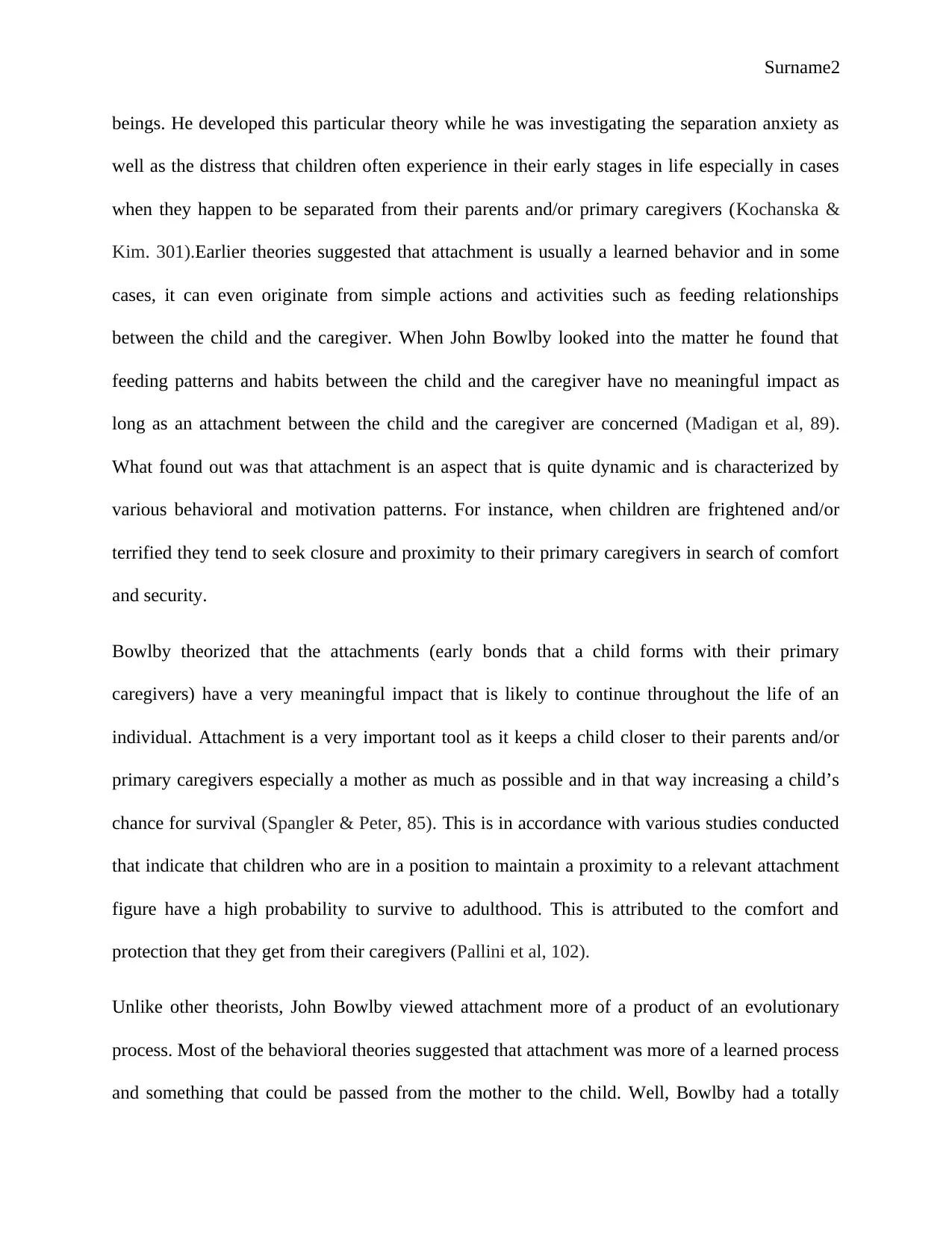
Surname2
beings. He developed this particular theory while he was investigating the separation anxiety as
well as the distress that children often experience in their early stages in life especially in cases
when they happen to be separated from their parents and/or primary caregivers (Kochanska &
Kim. 301).Earlier theories suggested that attachment is usually a learned behavior and in some
cases, it can even originate from simple actions and activities such as feeding relationships
between the child and the caregiver. When John Bowlby looked into the matter he found that
feeding patterns and habits between the child and the caregiver have no meaningful impact as
long as an attachment between the child and the caregiver are concerned (Madigan et al, 89).
What found out was that attachment is an aspect that is quite dynamic and is characterized by
various behavioral and motivation patterns. For instance, when children are frightened and/or
terrified they tend to seek closure and proximity to their primary caregivers in search of comfort
and security.
Bowlby theorized that the attachments (early bonds that a child forms with their primary
caregivers) have a very meaningful impact that is likely to continue throughout the life of an
individual. Attachment is a very important tool as it keeps a child closer to their parents and/or
primary caregivers especially a mother as much as possible and in that way increasing a child’s
chance for survival (Spangler & Peter, 85). This is in accordance with various studies conducted
that indicate that children who are in a position to maintain a proximity to a relevant attachment
figure have a high probability to survive to adulthood. This is attributed to the comfort and
protection that they get from their caregivers (Pallini et al, 102).
Unlike other theorists, John Bowlby viewed attachment more of a product of an evolutionary
process. Most of the behavioral theories suggested that attachment was more of a learned process
and something that could be passed from the mother to the child. Well, Bowlby had a totally
beings. He developed this particular theory while he was investigating the separation anxiety as
well as the distress that children often experience in their early stages in life especially in cases
when they happen to be separated from their parents and/or primary caregivers (Kochanska &
Kim. 301).Earlier theories suggested that attachment is usually a learned behavior and in some
cases, it can even originate from simple actions and activities such as feeding relationships
between the child and the caregiver. When John Bowlby looked into the matter he found that
feeding patterns and habits between the child and the caregiver have no meaningful impact as
long as an attachment between the child and the caregiver are concerned (Madigan et al, 89).
What found out was that attachment is an aspect that is quite dynamic and is characterized by
various behavioral and motivation patterns. For instance, when children are frightened and/or
terrified they tend to seek closure and proximity to their primary caregivers in search of comfort
and security.
Bowlby theorized that the attachments (early bonds that a child forms with their primary
caregivers) have a very meaningful impact that is likely to continue throughout the life of an
individual. Attachment is a very important tool as it keeps a child closer to their parents and/or
primary caregivers especially a mother as much as possible and in that way increasing a child’s
chance for survival (Spangler & Peter, 85). This is in accordance with various studies conducted
that indicate that children who are in a position to maintain a proximity to a relevant attachment
figure have a high probability to survive to adulthood. This is attributed to the comfort and
protection that they get from their caregivers (Pallini et al, 102).
Unlike other theorists, John Bowlby viewed attachment more of a product of an evolutionary
process. Most of the behavioral theories suggested that attachment was more of a learned process
and something that could be passed from the mother to the child. Well, Bowlby had a totally
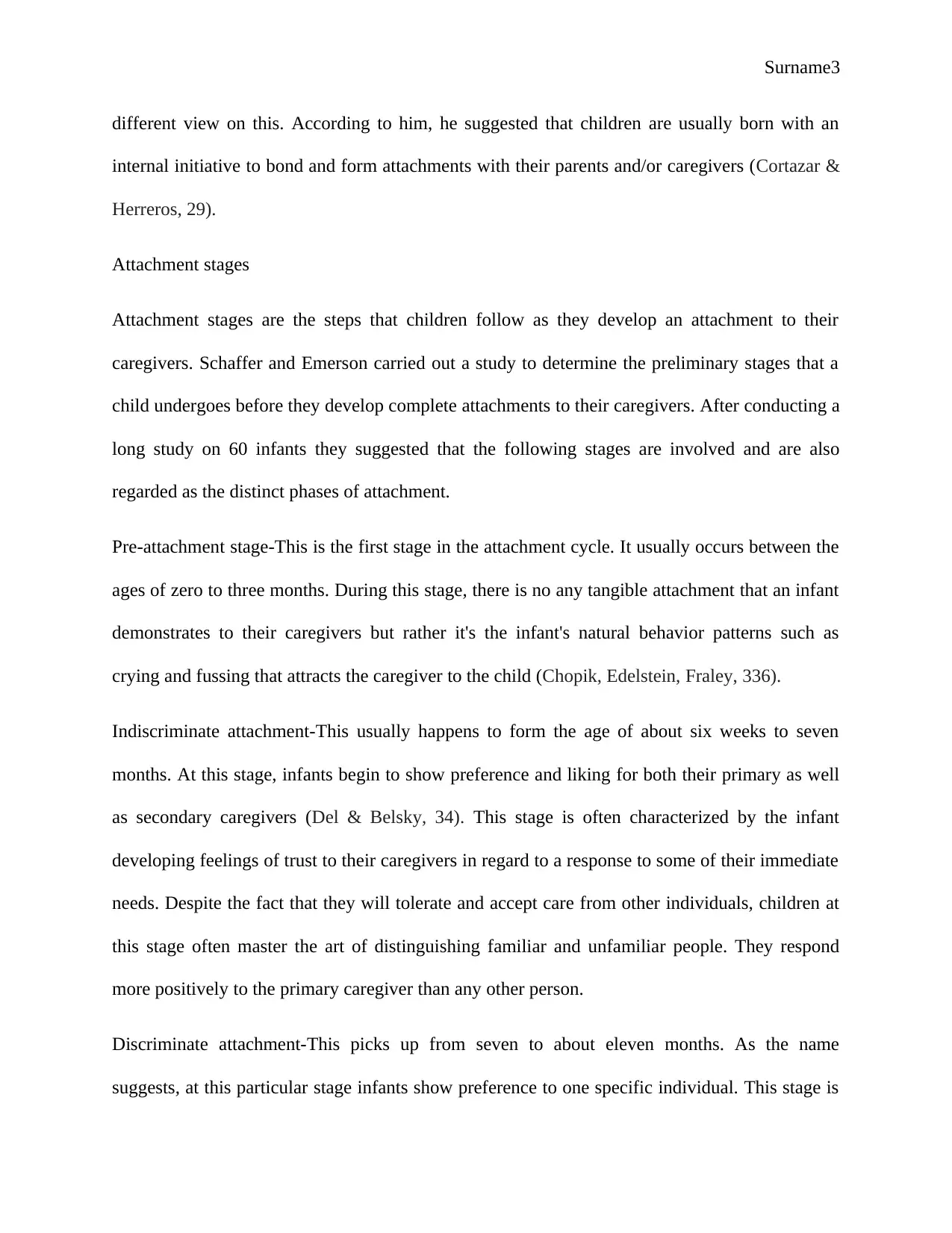
Surname3
different view on this. According to him, he suggested that children are usually born with an
internal initiative to bond and form attachments with their parents and/or caregivers (Cortazar &
Herreros, 29).
Attachment stages
Attachment stages are the steps that children follow as they develop an attachment to their
caregivers. Schaffer and Emerson carried out a study to determine the preliminary stages that a
child undergoes before they develop complete attachments to their caregivers. After conducting a
long study on 60 infants they suggested that the following stages are involved and are also
regarded as the distinct phases of attachment.
Pre-attachment stage-This is the first stage in the attachment cycle. It usually occurs between the
ages of zero to three months. During this stage, there is no any tangible attachment that an infant
demonstrates to their caregivers but rather it's the infant's natural behavior patterns such as
crying and fussing that attracts the caregiver to the child (Chopik, Edelstein, Fraley, 336).
Indiscriminate attachment-This usually happens to form the age of about six weeks to seven
months. At this stage, infants begin to show preference and liking for both their primary as well
as secondary caregivers (Del & Belsky, 34). This stage is often characterized by the infant
developing feelings of trust to their caregivers in regard to a response to some of their immediate
needs. Despite the fact that they will tolerate and accept care from other individuals, children at
this stage often master the art of distinguishing familiar and unfamiliar people. They respond
more positively to the primary caregiver than any other person.
Discriminate attachment-This picks up from seven to about eleven months. As the name
suggests, at this particular stage infants show preference to one specific individual. This stage is
different view on this. According to him, he suggested that children are usually born with an
internal initiative to bond and form attachments with their parents and/or caregivers (Cortazar &
Herreros, 29).
Attachment stages
Attachment stages are the steps that children follow as they develop an attachment to their
caregivers. Schaffer and Emerson carried out a study to determine the preliminary stages that a
child undergoes before they develop complete attachments to their caregivers. After conducting a
long study on 60 infants they suggested that the following stages are involved and are also
regarded as the distinct phases of attachment.
Pre-attachment stage-This is the first stage in the attachment cycle. It usually occurs between the
ages of zero to three months. During this stage, there is no any tangible attachment that an infant
demonstrates to their caregivers but rather it's the infant's natural behavior patterns such as
crying and fussing that attracts the caregiver to the child (Chopik, Edelstein, Fraley, 336).
Indiscriminate attachment-This usually happens to form the age of about six weeks to seven
months. At this stage, infants begin to show preference and liking for both their primary as well
as secondary caregivers (Del & Belsky, 34). This stage is often characterized by the infant
developing feelings of trust to their caregivers in regard to a response to some of their immediate
needs. Despite the fact that they will tolerate and accept care from other individuals, children at
this stage often master the art of distinguishing familiar and unfamiliar people. They respond
more positively to the primary caregiver than any other person.
Discriminate attachment-This picks up from seven to about eleven months. As the name
suggests, at this particular stage infants show preference to one specific individual. This stage is

Surname4
often characterized by actions of protest from the child especially when they are separated from
that person (Riggs, 40).
Multiple attachments-At around nine months of age, children move into another stage of
development that is characterized with them forming strong emotional bonds with other
caregivers apart from the primary caregiver. These could comprise of persons such as fathers,
siblings and other close relatives.
Pattern of attachment
There are four patterns of attachments as discussed below;
Secure attachments-This is an attachment pattern that is marked by high levels of distress upon
separation from a primary caregiver and so much joy when the caregiver returns. This usually
happens because children often feel secure around their caregivers and they happen to leave they
feeling of security is derived from them. When the caregiver returns the sense of security returns
as they know that their caregiver is around and would provide comfort to them when need be
(Spangler & Peter, 215?)
Ambivalent attachments-This is a special case of attachment where children become extremely
distressed when their caregivers leave. It is considered to be uncommon in comparison to other
patterns of attachments. Research and studies conducted indicate that ambivalent attachment is
often brought about by poor maternal availability.
Avoidant Attachments-Children with this kind of attachment pattern have the tendency of
avoiding their parents and/or primary caregivers. In cases where for instance a choice is provided
then these kinds of children that conform to this pattern of attachment will not show any
difference between their primary caregiver and a complete stranger (Morley &Moran, 77).
often characterized by actions of protest from the child especially when they are separated from
that person (Riggs, 40).
Multiple attachments-At around nine months of age, children move into another stage of
development that is characterized with them forming strong emotional bonds with other
caregivers apart from the primary caregiver. These could comprise of persons such as fathers,
siblings and other close relatives.
Pattern of attachment
There are four patterns of attachments as discussed below;
Secure attachments-This is an attachment pattern that is marked by high levels of distress upon
separation from a primary caregiver and so much joy when the caregiver returns. This usually
happens because children often feel secure around their caregivers and they happen to leave they
feeling of security is derived from them. When the caregiver returns the sense of security returns
as they know that their caregiver is around and would provide comfort to them when need be
(Spangler & Peter, 215?)
Ambivalent attachments-This is a special case of attachment where children become extremely
distressed when their caregivers leave. It is considered to be uncommon in comparison to other
patterns of attachments. Research and studies conducted indicate that ambivalent attachment is
often brought about by poor maternal availability.
Avoidant Attachments-Children with this kind of attachment pattern have the tendency of
avoiding their parents and/or primary caregivers. In cases where for instance a choice is provided
then these kinds of children that conform to this pattern of attachment will not show any
difference between their primary caregiver and a complete stranger (Morley &Moran, 77).
Secure Best Marks with AI Grader
Need help grading? Try our AI Grader for instant feedback on your assignments.
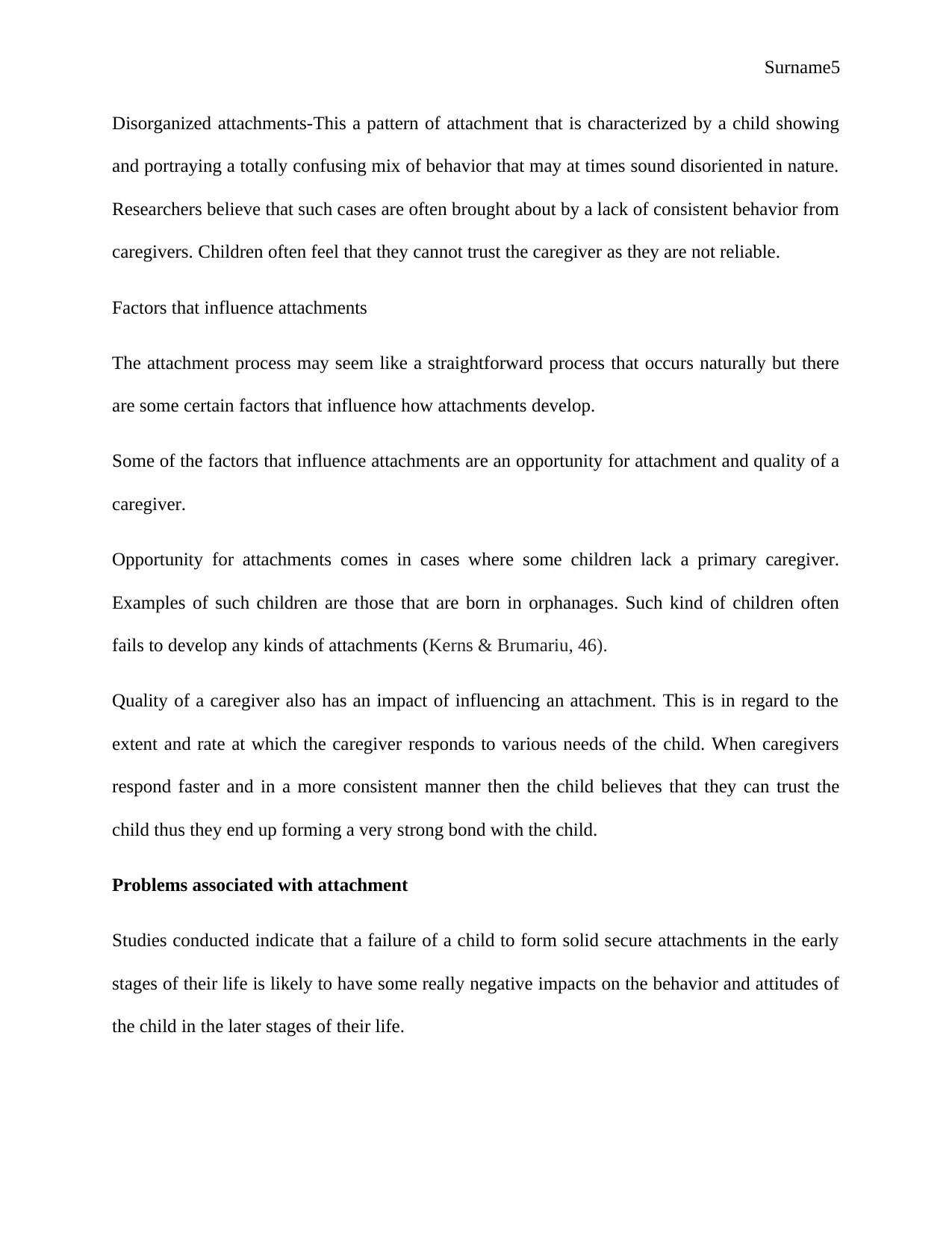
Surname5
Disorganized attachments-This a pattern of attachment that is characterized by a child showing
and portraying a totally confusing mix of behavior that may at times sound disoriented in nature.
Researchers believe that such cases are often brought about by a lack of consistent behavior from
caregivers. Children often feel that they cannot trust the caregiver as they are not reliable.
Factors that influence attachments
The attachment process may seem like a straightforward process that occurs naturally but there
are some certain factors that influence how attachments develop.
Some of the factors that influence attachments are an opportunity for attachment and quality of a
caregiver.
Opportunity for attachments comes in cases where some children lack a primary caregiver.
Examples of such children are those that are born in orphanages. Such kind of children often
fails to develop any kinds of attachments (Kerns & Brumariu, 46).
Quality of a caregiver also has an impact of influencing an attachment. This is in regard to the
extent and rate at which the caregiver responds to various needs of the child. When caregivers
respond faster and in a more consistent manner then the child believes that they can trust the
child thus they end up forming a very strong bond with the child.
Problems associated with attachment
Studies conducted indicate that a failure of a child to form solid secure attachments in the early
stages of their life is likely to have some really negative impacts on the behavior and attitudes of
the child in the later stages of their life.
Disorganized attachments-This a pattern of attachment that is characterized by a child showing
and portraying a totally confusing mix of behavior that may at times sound disoriented in nature.
Researchers believe that such cases are often brought about by a lack of consistent behavior from
caregivers. Children often feel that they cannot trust the caregiver as they are not reliable.
Factors that influence attachments
The attachment process may seem like a straightforward process that occurs naturally but there
are some certain factors that influence how attachments develop.
Some of the factors that influence attachments are an opportunity for attachment and quality of a
caregiver.
Opportunity for attachments comes in cases where some children lack a primary caregiver.
Examples of such children are those that are born in orphanages. Such kind of children often
fails to develop any kinds of attachments (Kerns & Brumariu, 46).
Quality of a caregiver also has an impact of influencing an attachment. This is in regard to the
extent and rate at which the caregiver responds to various needs of the child. When caregivers
respond faster and in a more consistent manner then the child believes that they can trust the
child thus they end up forming a very strong bond with the child.
Problems associated with attachment
Studies conducted indicate that a failure of a child to form solid secure attachments in the early
stages of their life is likely to have some really negative impacts on the behavior and attitudes of
the child in the later stages of their life.
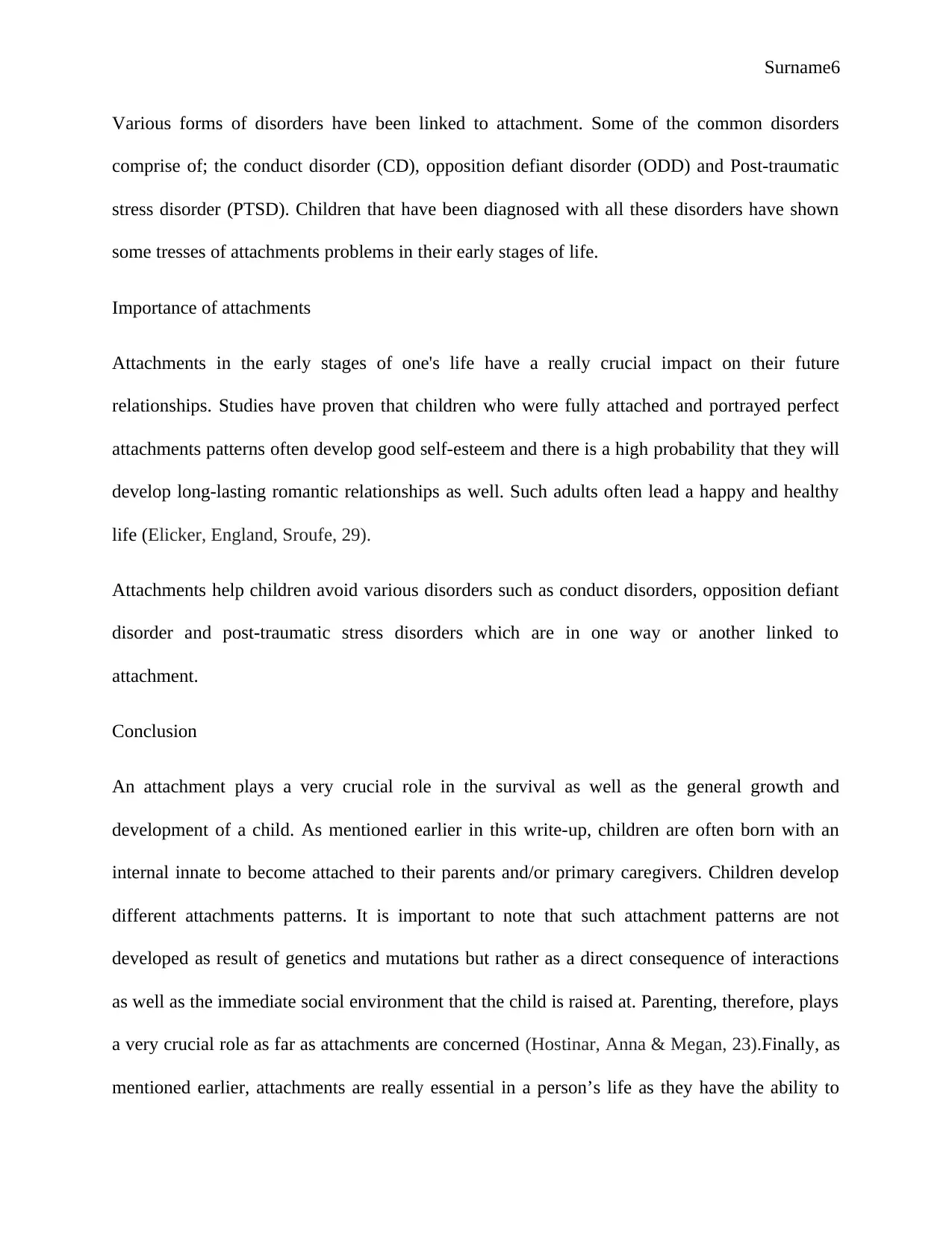
Surname6
Various forms of disorders have been linked to attachment. Some of the common disorders
comprise of; the conduct disorder (CD), opposition defiant disorder (ODD) and Post-traumatic
stress disorder (PTSD). Children that have been diagnosed with all these disorders have shown
some tresses of attachments problems in their early stages of life.
Importance of attachments
Attachments in the early stages of one's life have a really crucial impact on their future
relationships. Studies have proven that children who were fully attached and portrayed perfect
attachments patterns often develop good self-esteem and there is a high probability that they will
develop long-lasting romantic relationships as well. Such adults often lead a happy and healthy
life (Elicker, England, Sroufe, 29).
Attachments help children avoid various disorders such as conduct disorders, opposition defiant
disorder and post-traumatic stress disorders which are in one way or another linked to
attachment.
Conclusion
An attachment plays a very crucial role in the survival as well as the general growth and
development of a child. As mentioned earlier in this write-up, children are often born with an
internal innate to become attached to their parents and/or primary caregivers. Children develop
different attachments patterns. It is important to note that such attachment patterns are not
developed as result of genetics and mutations but rather as a direct consequence of interactions
as well as the immediate social environment that the child is raised at. Parenting, therefore, plays
a very crucial role as far as attachments are concerned (Hostinar, Anna & Megan, 23).Finally, as
mentioned earlier, attachments are really essential in a person’s life as they have the ability to
Various forms of disorders have been linked to attachment. Some of the common disorders
comprise of; the conduct disorder (CD), opposition defiant disorder (ODD) and Post-traumatic
stress disorder (PTSD). Children that have been diagnosed with all these disorders have shown
some tresses of attachments problems in their early stages of life.
Importance of attachments
Attachments in the early stages of one's life have a really crucial impact on their future
relationships. Studies have proven that children who were fully attached and portrayed perfect
attachments patterns often develop good self-esteem and there is a high probability that they will
develop long-lasting romantic relationships as well. Such adults often lead a happy and healthy
life (Elicker, England, Sroufe, 29).
Attachments help children avoid various disorders such as conduct disorders, opposition defiant
disorder and post-traumatic stress disorders which are in one way or another linked to
attachment.
Conclusion
An attachment plays a very crucial role in the survival as well as the general growth and
development of a child. As mentioned earlier in this write-up, children are often born with an
internal innate to become attached to their parents and/or primary caregivers. Children develop
different attachments patterns. It is important to note that such attachment patterns are not
developed as result of genetics and mutations but rather as a direct consequence of interactions
as well as the immediate social environment that the child is raised at. Parenting, therefore, plays
a very crucial role as far as attachments are concerned (Hostinar, Anna & Megan, 23).Finally, as
mentioned earlier, attachments are really essential in a person’s life as they have the ability to

Surname7
detect the person they are likely to become in their adulthood (Zeanah & Gleason, 78). For
instance, children who were fully attached and portrayed perfect attachments patterns often
develop good self-esteem and there is a high probability that they will develop long-lasting
romantic relationships as well. Such adults often lead a happy and healthy life.
detect the person they are likely to become in their adulthood (Zeanah & Gleason, 78). For
instance, children who were fully attached and portrayed perfect attachments patterns often
develop good self-esteem and there is a high probability that they will develop long-lasting
romantic relationships as well. Such adults often lead a happy and healthy life.
Paraphrase This Document
Need a fresh take? Get an instant paraphrase of this document with our AI Paraphraser
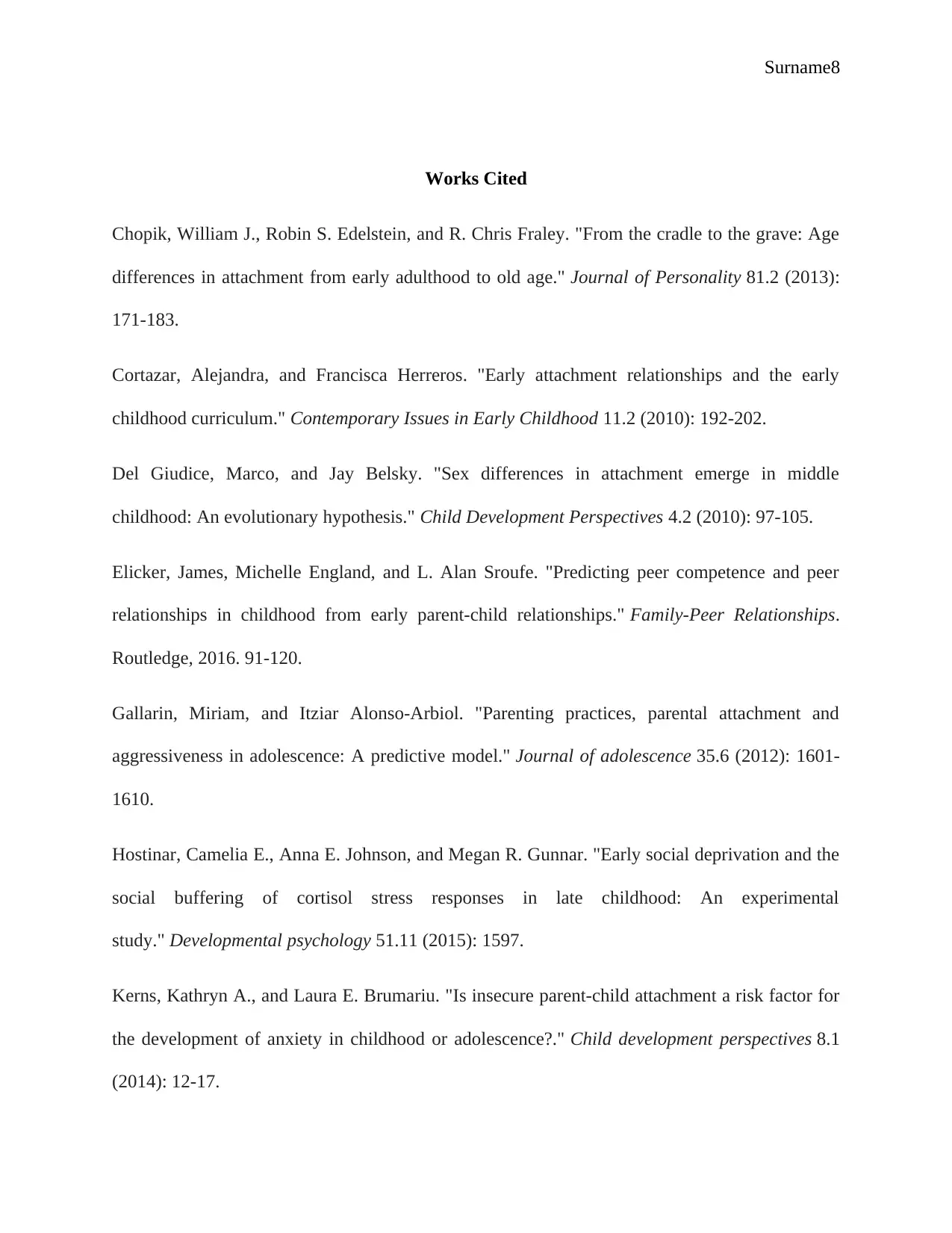
Surname8
Works Cited
Chopik, William J., Robin S. Edelstein, and R. Chris Fraley. "From the cradle to the grave: Age
differences in attachment from early adulthood to old age." Journal of Personality 81.2 (2013):
171-183.
Cortazar, Alejandra, and Francisca Herreros. "Early attachment relationships and the early
childhood curriculum." Contemporary Issues in Early Childhood 11.2 (2010): 192-202.
Del Giudice, Marco, and Jay Belsky. "Sex differences in attachment emerge in middle
childhood: An evolutionary hypothesis." Child Development Perspectives 4.2 (2010): 97-105.
Elicker, James, Michelle England, and L. Alan Sroufe. "Predicting peer competence and peer
relationships in childhood from early parent-child relationships." Family-Peer Relationships.
Routledge, 2016. 91-120.
Gallarin, Miriam, and Itziar Alonso-Arbiol. "Parenting practices, parental attachment and
aggressiveness in adolescence: A predictive model." Journal of adolescence 35.6 (2012): 1601-
1610.
Hostinar, Camelia E., Anna E. Johnson, and Megan R. Gunnar. "Early social deprivation and the
social buffering of cortisol stress responses in late childhood: An experimental
study." Developmental psychology 51.11 (2015): 1597.
Kerns, Kathryn A., and Laura E. Brumariu. "Is insecure parent-child attachment a risk factor for
the development of anxiety in childhood or adolescence?." Child development perspectives 8.1
(2014): 12-17.
Works Cited
Chopik, William J., Robin S. Edelstein, and R. Chris Fraley. "From the cradle to the grave: Age
differences in attachment from early adulthood to old age." Journal of Personality 81.2 (2013):
171-183.
Cortazar, Alejandra, and Francisca Herreros. "Early attachment relationships and the early
childhood curriculum." Contemporary Issues in Early Childhood 11.2 (2010): 192-202.
Del Giudice, Marco, and Jay Belsky. "Sex differences in attachment emerge in middle
childhood: An evolutionary hypothesis." Child Development Perspectives 4.2 (2010): 97-105.
Elicker, James, Michelle England, and L. Alan Sroufe. "Predicting peer competence and peer
relationships in childhood from early parent-child relationships." Family-Peer Relationships.
Routledge, 2016. 91-120.
Gallarin, Miriam, and Itziar Alonso-Arbiol. "Parenting practices, parental attachment and
aggressiveness in adolescence: A predictive model." Journal of adolescence 35.6 (2012): 1601-
1610.
Hostinar, Camelia E., Anna E. Johnson, and Megan R. Gunnar. "Early social deprivation and the
social buffering of cortisol stress responses in late childhood: An experimental
study." Developmental psychology 51.11 (2015): 1597.
Kerns, Kathryn A., and Laura E. Brumariu. "Is insecure parent-child attachment a risk factor for
the development of anxiety in childhood or adolescence?." Child development perspectives 8.1
(2014): 12-17.
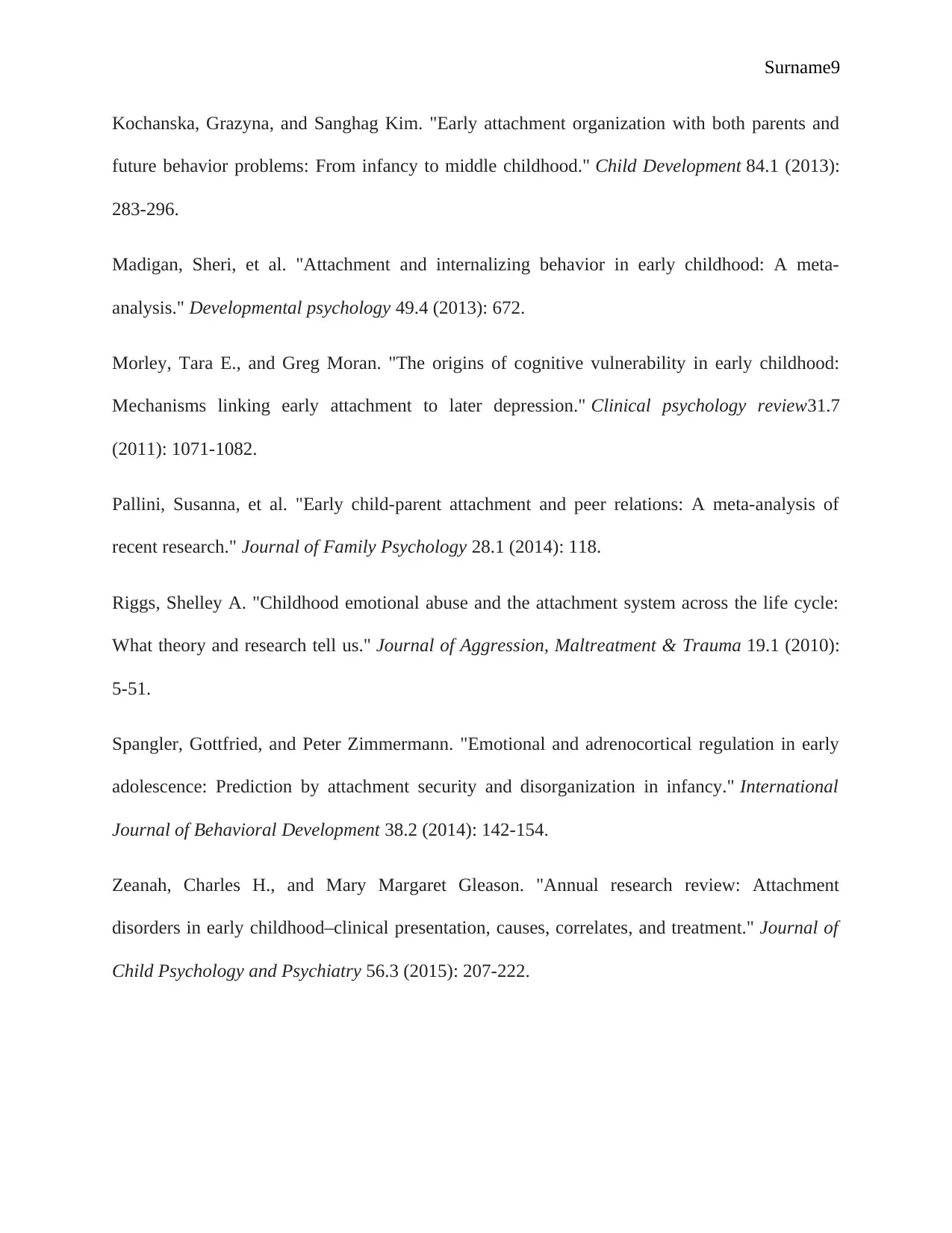
Surname9
Kochanska, Grazyna, and Sanghag Kim. "Early attachment organization with both parents and
future behavior problems: From infancy to middle childhood." Child Development 84.1 (2013):
283-296.
Madigan, Sheri, et al. "Attachment and internalizing behavior in early childhood: A meta-
analysis." Developmental psychology 49.4 (2013): 672.
Morley, Tara E., and Greg Moran. "The origins of cognitive vulnerability in early childhood:
Mechanisms linking early attachment to later depression." Clinical psychology review31.7
(2011): 1071-1082.
Pallini, Susanna, et al. "Early child-parent attachment and peer relations: A meta-analysis of
recent research." Journal of Family Psychology 28.1 (2014): 118.
Riggs, Shelley A. "Childhood emotional abuse and the attachment system across the life cycle:
What theory and research tell us." Journal of Aggression, Maltreatment & Trauma 19.1 (2010):
5-51.
Spangler, Gottfried, and Peter Zimmermann. "Emotional and adrenocortical regulation in early
adolescence: Prediction by attachment security and disorganization in infancy." International
Journal of Behavioral Development 38.2 (2014): 142-154.
Zeanah, Charles H., and Mary Margaret Gleason. "Annual research review: Attachment
disorders in early childhood–clinical presentation, causes, correlates, and treatment." Journal of
Child Psychology and Psychiatry 56.3 (2015): 207-222.
Kochanska, Grazyna, and Sanghag Kim. "Early attachment organization with both parents and
future behavior problems: From infancy to middle childhood." Child Development 84.1 (2013):
283-296.
Madigan, Sheri, et al. "Attachment and internalizing behavior in early childhood: A meta-
analysis." Developmental psychology 49.4 (2013): 672.
Morley, Tara E., and Greg Moran. "The origins of cognitive vulnerability in early childhood:
Mechanisms linking early attachment to later depression." Clinical psychology review31.7
(2011): 1071-1082.
Pallini, Susanna, et al. "Early child-parent attachment and peer relations: A meta-analysis of
recent research." Journal of Family Psychology 28.1 (2014): 118.
Riggs, Shelley A. "Childhood emotional abuse and the attachment system across the life cycle:
What theory and research tell us." Journal of Aggression, Maltreatment & Trauma 19.1 (2010):
5-51.
Spangler, Gottfried, and Peter Zimmermann. "Emotional and adrenocortical regulation in early
adolescence: Prediction by attachment security and disorganization in infancy." International
Journal of Behavioral Development 38.2 (2014): 142-154.
Zeanah, Charles H., and Mary Margaret Gleason. "Annual research review: Attachment
disorders in early childhood–clinical presentation, causes, correlates, and treatment." Journal of
Child Psychology and Psychiatry 56.3 (2015): 207-222.
1 out of 9
Related Documents
Your All-in-One AI-Powered Toolkit for Academic Success.
+13062052269
info@desklib.com
Available 24*7 on WhatsApp / Email
![[object Object]](/_next/static/media/star-bottom.7253800d.svg)
Unlock your academic potential
© 2024 | Zucol Services PVT LTD | All rights reserved.





